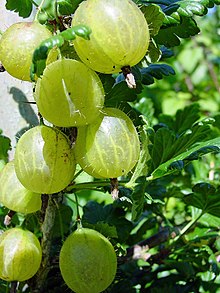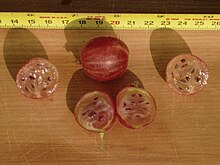ผู้ใช้:Janine janny/กระบะทราย9
| Ribes uva-crispa Gooseberry | |
|---|---|

| |
| Cultivated Eurasian gooseberry | |
| การจำแนกชั้นทางวิทยาศาสตร์ | |
| อาณาจักร: | Plantae |
| ไม่ได้จัดลำดับ: | Angiosperms |
| ไม่ได้จัดลำดับ: | Eudicots |
| ไม่ได้จัดลำดับ: | Core eudicots |
| อันดับ: | Saxifragales |
| วงศ์: | Grossulariaceae |
| สกุล: | Ribes |
| สปีชีส์: | R. uva-crispa |
| ชื่อทวินาม | |
| Ribes uva-crispa L. | |
| ชื่อพ้อง[1] | |
|
รายการ
| |
กูสเบอร์รี่ (/ˈɡuːsbɛri/ หรือ /ˈɡuːzbɛri/ (ออกเสียงแบบAmerican) หรือ /ˈɡʊzbəri/ (ออกเสียงแบบBritish)),[2]มีชื่อทางวิทยาศาสตร์ว่า Ribes uva-crispa (และ syn. Ribes grossularia), เป็นหนึ่งในสายพันธุ์ของ Ribes (ซึ่งรวมถึง currantsด้วย) เป็นพืชพื้นเมืองใน ยุโรป, แอฟริกันตะวันตกเฉียงเหนือ และตะวันตก และตะวันออกเฉียงใต้ของเอเชีย กูสเบอร์รี่ลำต้นเป็นพุ่ม ผลสามารถกินได้ และผลผลิตปลูกเพื่อการค้าและการบริโภค
ถึงแม้ว่ามักจะถูกจับให้อยู่ในสกุลย่อยในสกุล Ribes แต่ก็มีนักอนุกรมวิธาน จำนวนไม่มากนัก จัดกลุ่ม Grossularia เป็นสกุลแยกออกมา แม้ว่าการผสมพันธุ์ ระหว่างกูสเบอร์รี่และแบล็คเคอแรนท์ (เช่น jostaberry) จะเป็นไปได้ แต่สกุลย่อย Grossularia ก็มีความแตกต่างจาก เบอร์รี่สกุล เคอแรนท์ ซึ่งส่วนใหญ่มีก้านหนาม และดอกจะออกประมาณ 1-3 ดอกในหนึ่งก้าน แต่ไม่ออกดอกเป็นช่อ กูสเบอร์รี่เป็นหนึ่งในพรรณที่คล้ายๆ กันในกลุ่มสกุลย่อย Grossularia ที่เป็นพรรณใกล้เคียงกัน(เช่น กูสเบอร์รี่อเมริกาเหนือ Ribes hirtellum) ซึ่งอยู่ในสกุล Ribesเช่นเดียวกัน
ถิ่นที่ปลูกและลักษณะทางกายภาพ[แก้]
กูสเบอร์รี่เป็น ไม้พุ่มแผ่กระจายออกด้านข้าง สามารถโตสูงและกว้างได้ถึง1.5 เมตร (5 ฟุต)[3] กิ่งก้านแผ่หนาแน่นและมีหนามแหลม สามารถยืนต้นเดี่ยวหรือขึ้นกระจุกตัวสองหรือสามต้นจากลำต้น ซึ่งก้านสั้นจะแผ่ขยายออกไปตามด้านข้าง รูปทรงของดอกเป็นรูประฆัง ออกดอกเดี่ยวหรืออกดอกเป็นคู่ ใบหยักลึก แตกใบเป็นกลุ่ม 3 หรือ 5 ใบ ผลของกูสเบอร์รี่ป่าจะเล็กกว่าสายพันธุ์ที่เพาะปลูก แต่มักจะมีรสชาติที่ดีกว่า มีขนตามธรรมชาติ แต่เป็นขนนุ่ม ซึ่งมีการอธิบายประกอบ R. uva-crispa ว่าผลเบอร์รี่มักมีสีเขียว แต่ก็มีบ้างที่มีสีแดง (อมม่วง), เหลือง และสีขาวแตกต่างกัน[3] (ผลของ Ribes hirtellum สีเขียวหรือม่วงเข้มถึงดำ[4])
การกระจายพันธุ์และภูมิอากาศ[แก้]

การปลูกกูสเบอร์รี่เป็นที่นิยมในศตวรรษที่ 19 ซึ่งมีบันทึกไว้ในปี 1879[5]
กูสเบอร์รี่เป็นพืชเฉพาะถิ่นในหลายพื้นที่ของยุโรป และใน เอเชียตะวันตก เติบโตตามธรรมชาติตามที่รกชัฏในเทือกเขาแอลป์ หรือ ป่า ป่าหินในประเทศที่ราบต่ำกว่า จากทางตะวันออกของฝรั่งเศส ไปจนถึงเทือกเขาหิมาลัยและคาบสมุทรอินเดีย ในเกาะอังกฤษ กูสเบอร์รี่มักพบในป่าละเมาะและตามรั้วไม้ และตามซากปรักหักพักเก่า แต่ก็มีการเพาะปลูกกูสเบอร์รี่มานานแล้ว แต่เป็นเรื่องจากที่จะขยายพันธุ์จากกิ่งกูสเบอร์รี่ป่า หรือกำหนดให้กูสเบอร์รี่พื้นเมืองเจริญเติบโตสมบูรณ์เฉพาะพื้นที่ในเกาะอังกฤษ กูสเบอร์รี่มักขึ้นทั่วไปในพื้นที่ลาดเอียง เชิงเขาของเทือกเขา แอลป์ และซาวอย แต่ไม่มีหลักฐานแต่ชัดว่ากูสเบอร์รี่เป็นที่รู้จักของชาวโรมันหรือไม่ ถึงแม้ว่าจะเป็นไปได้ที่มีบันทึกอ้างถึงในบางส่วนของบันทึกประวัติศาสตร์ธรรมชาติ ของPliny the Elder กล่าวไว้ว่า ตั้งแต่อดีตถึงปัจจุบันในฤดูร้อนของ อิตาลี จะไม่เหมาะสมแก่การเพาะปลูก ทั้งๆ ที่ปัจจุบันกูสเบอร์รี่จะได้รับความนิยมอย่างมากในเยอรมนีและฝรั่งเศส แต่ก็ไม่ปรากฏหลักฐานว่ามีการปลูกในบริเวณพื้นที่ดังกล่าวในยุคกลาง, ผลกูสเบอร์รี่ป่าได้รับความสำคัญทางการแพย์ อย่างมากซึ่งมีคุณสมบัติเย็นจากกรดในน้ำกูสเบอร์รี่เพื่อช่วยในการลดไข้ ในภาษาอังกฤษเก่า<nowiki>เรียกว่า Fea-berry ซึ่งยังคงถูกเรียกในภาษาถิ่นในบางพื้นที่ จึงระบุได้ว่ากูสเบอร์รี่เป็นที่นิยมโดยทั่วไปในเกาะอังกฤษซึ่งปลูกมากในสวนต่างๆ ในช่วงเวลาก่อนหน้า
William Turner บรรยายกูสเบอร์นี่ในหนังสือ Herball ของเขาว่าช่วงกลางศตวรรษที่ 16 ในหลายปีหลังจากนั้นได้กล่าวถึงบทหนึ่งในกวีอันน่ามหัศจรรย์ ของ Thomas Tusser ว่าเป็นพืชหลักในวัฒนธรรมการจัดสวน สายพุนธุ์ของกูสเบอร์รี่ที่ได้รับการปรับปรุงสายพันธุ์แล้วน่าจะมีการนำมาปลูกครั้งแรกโดยนักชำนาญการด้านทางจัดสวนของฮอลแลนด์ ซึ่งตั้งชื่อกูสเบอร์รี่ว่า Kruisbezie ซึ่งอาจเพี้ยนมาเป็นคำในภาษาอังกฤษที่ใช้ในปัจจุบัน ต่อเนื่องถึงปลายศตวรรษที่ 18 กูสเบอร์รี่กลายเป็นพรรณพืชที่ได้รับความนิยมใช้ในการจัดสวนแบบ cottage โดยเฉพาะอย่างยิ่งในแลนคาเชอร์ ซึ่งใช้เครื่องปั่นฝ้าย ในการพัฒนาสายพันธุ์ให้หลากหลายโดยใช้เมล็ด ซึ่งเป็นผลให้ได้ผลกูสเบอร์รี่ที่ใหญ่ขึ้น[5]

ภูมิอากาศของบริติชไอลส์เหมาะสมอย่างมากซึ่งทำให้ได้กูสเบอร์รี่ที่สมบูรณ์แบบ และจะให้ผลผลิตที่ดีหากปลูกทางตอนเหนือสุดของสก๊อตแลนด์ ซึ่งตามความจริงแล้วสรชาติของกูสเบอร์รี่จะดีขึ้นหากปลูกในละติจูดที่สูงขึ้น ในนอร์เวย์ พุ่มกูสเบอร์รี่เจริญงอกงามดีในสวน ทางชายฝั่งตะวันตกใกล้กับอาร์กติกเซอร์เคิล และกูสเบอร์รี่ยังพบเห็นในป่าไกลไปทางเหนือที่เส้น 63° อีกด้วย ฤดูร้อนอันแห้งแล้งของฝรั่งเศสและเยอรมนีไม่เหมาะสมเลยให้การเจริญเติบโตของกูสเบอร์รี่ ถึงแม้ว่าจะปลูกได้ในบางพื้นที่เชิงเขาจะประสบความสำเร็จค่อนข้างดี กูสเบอร์รี่ทางตอนใต้ของอังกฤษ จะเติบโตได้ดีหากอยู่ในอากาศที่เย็น และมักจะถูกพบเห็นในสวนดอกไม้ใกล้ ลอนดอน ซึ่งเติบโตได้ดีใต้เงาต้นแอปเปิ้ล แต่ทางตอนเหนือต้องอาศัยแสงแดดจัดจากดวงอาทิตย์ที่จะช่วยให้กูสเบอร์รี่เจริญเติบโตได้อย่างสมบูรณ์ กูสเบอร์รี่สามารถเติบโตได้ในดินเกือบทุกประเภท แต่จะดีสุดในดินร่วนที่อุดมสมบูรณ์ หรือในตะกอนดินดำ และถึงแม้ว่าจะอยู่รอดในพื้นที่แห้งแล้งแต่จะดีกว่าหากอยู่ในพื้นที่ชุ่มชิ้นที่ระบายน้ำได้ดี[5]
กูสเบอร์รี่ถูกพบได้ในหลายพื้นที่ทุกหนทุกแห่งของอดีตของเชคโกสโลเวเกีย

การเกษตรกรรม[แก้]
การขยายพันธุ์กูสเบอร์รี่ด้วยการตอนกิ่งจะได้ผลดีกว่าการเพาะเมล็ด กิ่งตอนจะออกรากได้อย่างรวดเร็วในฤดูใบไม้ล่วงและจะเริ่มออกผลภายในเวลาไม่กี่ปีThose growing from seeds will rapidly produce healthy heavily yielding bushes. Pruning should be carried out to allow light in and give the new growth for next year's branches an opportunity to grow. Fruit is produced on lateral spurs and on the previous year's shoots.[5] The main aim is to let the light in and a subsidiary purpose is to allow picking without excessive scratching from the spines.
Heavy nitrogen composting must be avoided as too much nitrogen will produce extensive growth and weaken the bush. This will make the bush susceptible to mildew. The fruit should best be picked off when large to reach maximum sweetness. Supermarkets tend to have theirs picked early and before they are ripe and sweet to give a long shelf life. Heavily laden branches should be cut off complete with berries, this really benefits future crops as it lets the light reach the new growth. Cultivar 'Invicta' now is a popular green gooseberry which has some mildew resistance.[6]

Cultivars[แก้]
Numerous cultivars have been developed for both commercial and domestic use. The following have gained the Royal Horticultural Society's Award of Garden Merit:[6]-
- 'Careless'
- 'Greenfinch'
- 'Invicta'
- 'Leveller'
- 'Whinham's Industry'
Pests[แก้]
Gooseberry bushes are vulnerable to magpie moth (Abraxas grossulariata) caterpillars.[5] In cultivation, the best method for removing them is to remove the larvae by hand soon after they hatch; its eggs are laid on fallen gooseberry leaves.[5]
Other potential threats are V-moth (Macaria wauaria) and Gooseberry sawfly (Nematus ribesii).[5] Nematus ribesii grubs will bury themselves in the ground to pupate; on hatching into adult form, they lay their eggs, which soon hatch into larvae, on the underside of gooseberry leaves. Insecticides used in the 19th-century against these included tar water, weak solutions of carbolic acid, and powdered hellebore, which worked against magpie moths and V-moths as well as gooseberry sawflies. (Foxglove and tobacco infusions were also sometimes used.) Careful removal of fallen leaves and tilling of the ground around the plant will also destroy most eggs and chrysalises of these insects.
Potassium sulphide was known to be an effective treatment for blights and other parasitic growths, such as American gooseberry mildew.
Note that like most Ribes, the gooseberry is a potential host for white pine blister rust, which can cause serious damage to white pines;[8] thus, gooseberry cultivation is illegal in some areas of the U.S. Quarantines are in place to help control this disease. Maine law prohibits the planting and cultivation of currants and gooseberries in most of southern Maine, and prohibits the planting and cultivation of European black currants and their hybrids anywhere within the state.
Culinary uses[แก้]
| คุณค่าทางโภชนาการต่อ 100 กรัม (3.5 ออนซ์) | |
|---|---|
| พลังงาน | 184 กิโลจูล (44 กิโลแคลอรี) |
10.18 g | |
| ใยอาหาร | 4.3 g |
0.58 g | |
0.88 g | |
| วิตามิน | |
| วิตามินเอ | (2%) 15 μg |
| ไทอามีน (บี1) | (3%) 0.04 มก. |
| ไรโบเฟลวิน (บี2) | (3%) 0.03 มก. |
| ไนอาซิน (บี3) | (2%) 0.3 มก. |
(6%) 0.286 มก. | |
| วิตามินบี6 | (6%) 0.08 มก. |
| โฟเลต (บี9) | (2%) 6 μg |
| วิตามินซี | (33%) 27.7 มก. |
| วิตามินอี | (2%) 0.37 มก. |
| แร่ธาตุ | |
| แคลเซียม | (3%) 25 มก. |
| เหล็ก | (2%) 0.31 มก. |
| แมกนีเซียม | (3%) 10 มก. |
| แมงกานีส | (7%) 0.144 มก. |
| ฟอสฟอรัส | (4%) 27 มก. |
| โพแทสเซียม | (4%) 198 มก. |
| โซเดียม | (0%) 1 มก. |
| สังกะสี | (1%) 0.12 มก. |
| องค์ประกอบอื่น | |
| น้ำ | 87.87 g |
| ประมาณร้อยละคร่าว ๆ โดยใช้การแนะนำของสหรัฐสำหรับผู้ใหญ่ แหล่งที่มา: USDA FoodData Central | |
Gooseberries are edible and can be eaten as-is, or used as an ingredient in desserts, such as pies, fools and crumbles. Early pickings are generally sour and more appropriate for culinary use. They are also used to flavour beverages such as sodas, flavoured waters, or milk, and can be made into fruit wines and teas. Gooseberries can be preserved in the form of jams, dried fruit, or as the primary or a secondary ingredient in pickling, or stored in sugar syrup. In the UK gooseberries were particularly popular before fruit was imported in quantity from elsewhere, as they constituted the first available fresh fruit of the year.[ต้องการอ้างอิง]
Etymology[แก้]

The "goose" in "gooseberry" has usually been seen as a corruption of either the Dutch word kruisbes or the allied German Krausbeere, or of the earlier forms of the French groseille. Alternatively the word has been connected to the Middle High German krus (curl, crisped), in Latin as grossularia. However, the Oxford English Dictionary takes the obvious derivation from goose and berry as probable because "the grounds on which plants and fruits have received names associating them with animals are so often inexplicable that the inappropriateness in the meaning does not necessarily give good grounds for believing that the word is an etymological corruption." It is also perhaps worth noting that the French for gooseberry is groseille à maquereau translated as 'mackerel berries'.[9]
It is also possible that it might be a corruption of "goods berry" (since that is what the Old English fēāberige literally means - see above in 'Distribution'), although what connection there may be to 'goods' is no longer known.
"Gooseberry bush" was 19th-century slang for pubic hair, and from this comes the saying that babies are "Born under a gooseberry bush."[10]
The specific epithet uva-crispa literally means "curved grape".[11]
References[แก้]
- ↑ "The Plant List: A Working List of All Plant Species". สืบค้นเมื่อ 26 July 2014.
- ↑ Oxford English Dictionary 2nd edition, 1989. Accessed online 22 April 2010. (Note however that the OED has final /ɪ/, as this entry predates its acceptance of happy-tensing.)
- ↑ 3.0 3.1 Harry Baker (1999). Growing Fruit. Octopus Publishing Group. p. 70. ISBN 9781840001532.
- ↑ "Northern Ontario Plant Database". สืบค้นเมื่อ 26 July 2014.
- ↑ 5.0 5.1 5.2 5.3 5.4 5.5 5.6 Baynes, T.S. (1879). The Encyclopaedia Britannica: A Dictionary of Arts, Sciences, and General Literature. C. Scribner's sons. p. 779.
- ↑ 6.0 6.1 http://apps.rhs.org.uk/agm/Award2.asp?User2=Fr&crit=ribes
- ↑ Prof. Dr. Otto Wilhelm Thomé Flora von Deutschland, Österreich und der Schweiz 1885
- ↑ American Phytopathological Society. White Pine Blister Rust.
- ↑ Online Etymology Dictionary
- ↑ Gooseberry QI: Quite Interesting facts about costermongers, Daily Telegraph, 19 September 2012.
- ↑ Harrison, Lorraine (2012). RHS Latin for gardeners. United Kingdom: Mitchell Beazley. p. 224. ISBN 9781845337315.
 บทความนี้ ประกอบด้วยข้อความจากสิ่งพิมพ์ซึ่งปัจจุบันเป็นสาธารณสมบัติ: Chisholm, Hugh, บ.ก. (1911). สารานุกรมบริตานิกา ค.ศ. 1911 (11 ed.). สำนักพิมพ์มหาวิทยาลัยเคมบริดจ์.
บทความนี้ ประกอบด้วยข้อความจากสิ่งพิมพ์ซึ่งปัจจุบันเป็นสาธารณสมบัติ: Chisholm, Hugh, บ.ก. (1911). สารานุกรมบริตานิกา ค.ศ. 1911 (11 ed.). สำนักพิมพ์มหาวิทยาลัยเคมบริดจ์. {{cite encyclopedia}}:|title=ไม่มีหรือว่างเปล่า (help)
